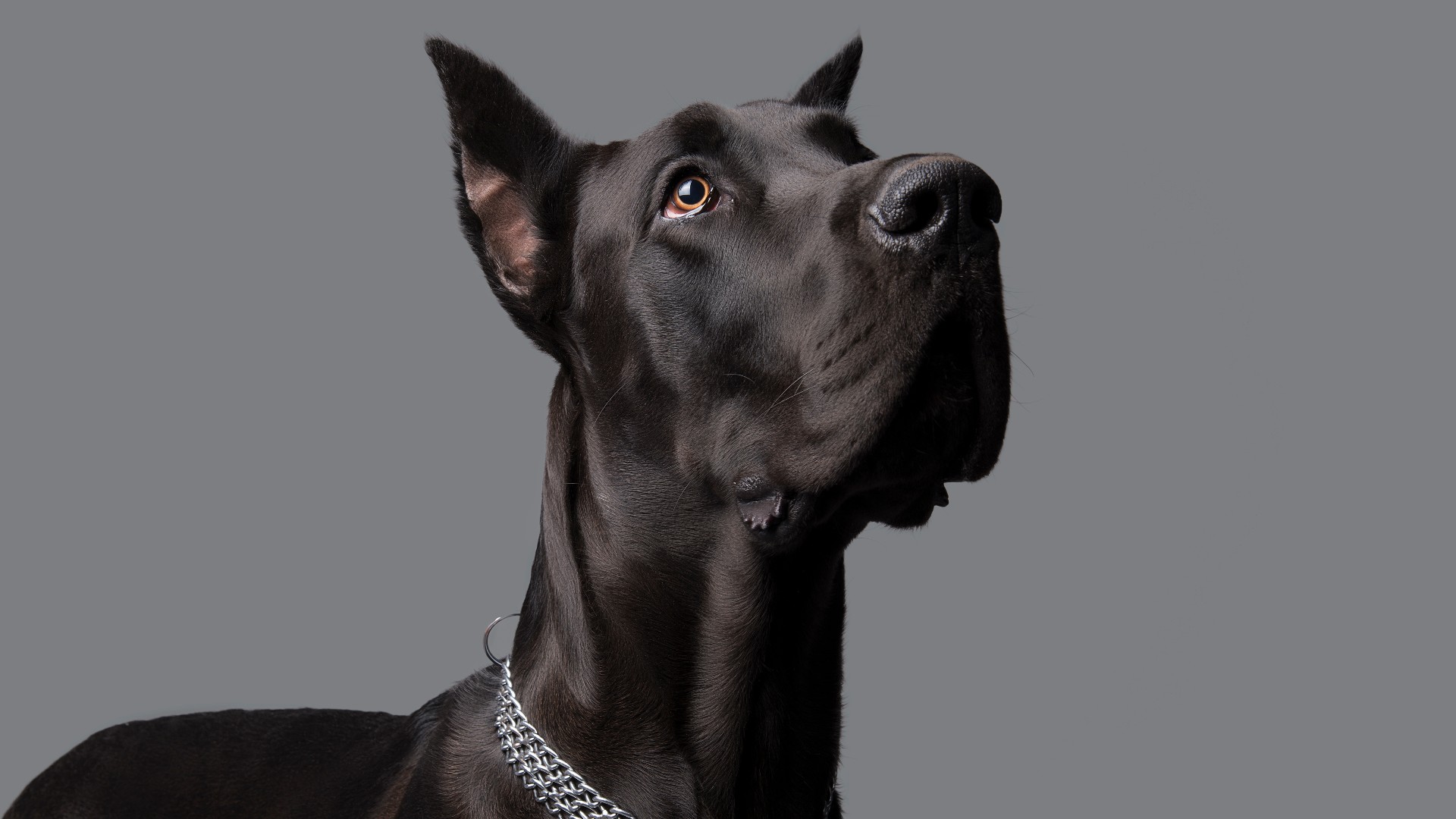Great Dane: Breed profile
The Great Dane is a gentle giant who makes a loving and sweet-natured family companion

While its name may understandably lead you to believe that the Great Dane hails from Denmark, this noble breed originated in Germany, where it was used to hunt wild boar. The Great Dane is thought to be a product of the Mastiff and the Greyhound, which have contributed to their heft and sleek physique, and the Irish Wolfhound, responsible for the Great Dane's imposing height.
Standing as tall as 32 inches at the shoulders, this hunting breed towers over most other dogs, including German Shepherds, but don’t let their height fool you. The Great Dane may have a substantial stature, but these gentle giants are all heart and make sweet and lovable companions. While they may be friendly, they also possess a courageous spirit that makes them loyal and protective towards those they love.
Despite its size, you’ll be relieved to know the Great Dane doesn’t require excessive amounts of exercise and is content with one or two short and brisk walks a day. Believe it or not, he also makes an excellent apartment dog thanks to his calm nature and while wonderful with children, much like the Cane Corso, training is needed to ensure he doesn’t accidentally knock young toddlers off their feet.
How much exercise does a Great Dane need?
Life expectancy: 7-10 years
Average weight: Male: 140-175lbs/63-80kg Female: 110-140lbs/50-63kg
About the same as: 450 bananas
While the Great Dane loves his daily strolls, large amounts of exercise aren’t required to keep this breed happy and healthy. Brisk walks of around 20-30 minutes once or twice a day are perfect for well-socialized and well-trained Danes who will happily spend the rest of their day lazing by your side.
If you’re looking for a hiking or jogging companion, the Great Dane will happily oblige but care needs to be taken. Avoid exercising too soon after a meal, as Danes are prone to bloating, and ensure you wait until your dog is at least 2 years old to start jogging with them, as their growing joints take longer to develop than other breeds.
Due to the deeply embedded hunting instincts in their DNA, Danes are prone to charging off and following whatever scent their nose picks up. For their safety, always keep your Dane on a leash and only let them loose in areas with high fences.

Are Great Danes easy to train?
Suitable for: Those looking for a loving and affectionate family companion
Not suitable for: People who are looking for a dog that can be left home alone unsupervised or who don’t have time for training
Temperament: Friendly, patient, dependable, spirited, courageous
Shedding: Medium
While they may be gentle and sweet-natured, Great Danes have a large, imposing, and powerful presence that requires early training to ensure they don’t accidentally hurt anyone. They’re highly sociable and love being around people, but they need to be taught from a young age not to jump up on people or nip when trying to protect their family.
Get the best advice, tips and top tech for your beloved Pets
Puppy training and obedience classes from around 10 weeks of age are highly recommended for this breed, as is exposure to a wide range of people. This will help your Dane learn how to socialize appropriately and prevent them from becoming headstrong.
While training is vital no matter the home environment, it is particularly important in homes with young toddlers, who Danes can accidentally knock over with their strong wagging tails. The great news is that this breed has a friendly and eager-to-please nature, which makes training them a joy.
What do Great Danes eat?
As one of the largest dog breeds, Great Danes require around 2,500 to 3,000 calories a day and do best on a high-protein and moderate-fat diet. When choosing the best dry dog food or best wet dog food for your Dane, look for a calorie count of between 350 and 450 per cup.
Portion size is crucial with this breed as the number one cause of death among Great Danes is bloat. Large meals can increase the risk of the stomach becoming twisted, so make sure mealtimes are scheduled with no free grazing in between and monitor your Dane to ensure he doesn’t eat too quickly.
To meet the unique nutritional needs of your Great Dane, we recommend choosing a dog food that has been specially formulated for large breeds. This will ensure your canine companion is getting the right ratio of macro and micro-nutrients for optimal health.
What is the temperament of a Great Dane like?

A loving and sweet gentle giant, Great Danes are one of the more affectionate dog breeds and adore people. He is a true indoor dog who loves being part of the family and is friendly and patient with both adults and children.
While not aggressive, the tenderness he feels towards his family lends itself to a high level of protectiveness that can see him quickly become alert and on guard if he senses a threat. Training is required to ensure he learns how to channel this appropriately and doesn’t try to nip innocent visitors or bystanders out of loyalty to his humans.
Great Danes love children and make great family companions, but unless very well trained, they’re best suited to homes with older children who won’t find themselves being accidentally bowled over by these impressively sized canines.
The Great Dane is the epitome of a laid-back dog breed. Not much ruffles the fur of this calm and placid pooch, making him suitable for a wide range of living situations. He housetrains easily but is best not left alone as he can cause a fair amount of damage when bored and away from his family.
How much grooming does a Great Dane need?
While his short and smooth coat doesn’t shed much most of the year, requiring a simple weekly brush, during peak shedding season daily brushes are recommended.
The best dog brushes come in a range of different options, with the Dane's coat responding best to a rubber mitt or soft bristle brush. Unless your Dane gets super dirty, occasional baths are ample.
Grooming is minimal with this breed, but you’ll still want to trim their nails regularly and brush their teeth frequently.
Wisdom Panel Breed Discovery DNA Kit | Amazon
Not sure exactly what breed your dog is? This kit screens for 365+ breeds – because knowing every detail about your dog helps you understand how best to care for them.
How healthy are Great Danes?
Amount Of Shedding: Moderate
Easy To Groom: Yes
General Health: Fair
Potential For Weight Gain: Moderate
While all dogs have their health problems, Great Danes are known for having more than their fair share. The number-one killer of Danes is bloat, a condition where the stomach becomes filled with air and can become twisted, cutting off the blood supply. Emergency life-saving surgery is the only option when this happens, so owners should educate themselves on the signs to ensure they can act swiftly.
We recommend you have a chat with your vet about how to manage this condition and to discuss whether your dog might be a suitable candidate for having their stomach tacked. This procedure can stop the stomach from twisting and many owners of Danes have it done as a preventative measure.
Great Danes can also suffer from cardiomyopathy, a disease of the heart muscle, and hip dysplasia, a malformation of the hip socket that may need surgery and can lead to arthritis. The American Kennel Club recommends hip and cardiac exams be carried out early as many of the conditions that Danes are prone to can be treated with medication.
You may also wish to consider investing in the best pet insurance to help manage the costs of any treatment your Dane may require.
Should I get a Great Dane?

If you’re in search of a lovable and gentle canine companion who is loyal and patient, then the Great Dane just might be your perfect match. They make wonderful members of the family who get along beautifully with adults and children, although they do require training from a young age to ensure their large size doesn’t do any accidental damage.
They’re non-demanding when it comes to exercise, requiring around 30 minutes a day to keep them healthy, and their low-maintenance coat makes grooming a breeze for busy pet parents.
Their shorter life span and health issues are worth taking into consideration, as being a larger dog they don’t live as long as other breeds, and their potential medical problems may prove costly for those on smaller budgets.
Those drawbacks aside, Great Danes are friendly, sweet-natured, and calm with people with hearts that contain bucket loads of love and affection. They’re perfect for anyone looking for a canine companion who will well and truly become part of the family.
Want to learn more about this breed? Here are our favorite Great Dane facts. Or check out our comparison between the Great Dane vs Irish Wolfhound

Kathryn is a freelance writer who has been a member of the PetsRadar family since it launched in 2020. Highly experienced in her field, she's driven by a desire to provide pet parents with accurate, timely, and informative content that enables them to provide their fur friends with everything they need to thrive.
Kathryn works closely with vets and trainers to ensure all articles offer the most up-to-date information across a range of pet-related fields, from insights into health and behavior issues to tips on products and training.
When she’s not busy crafting the perfect sentence for her features, buying guides and news pieces, she can be found hanging out with her family (which includes one super sassy cat and a kitten), drinking copious amounts of Jasmine tea and reading all the books.
She has written for a range of publications, including Fit&Well, Top Ten Reviews, LiveScience, Goodto, and Product Hunt.

